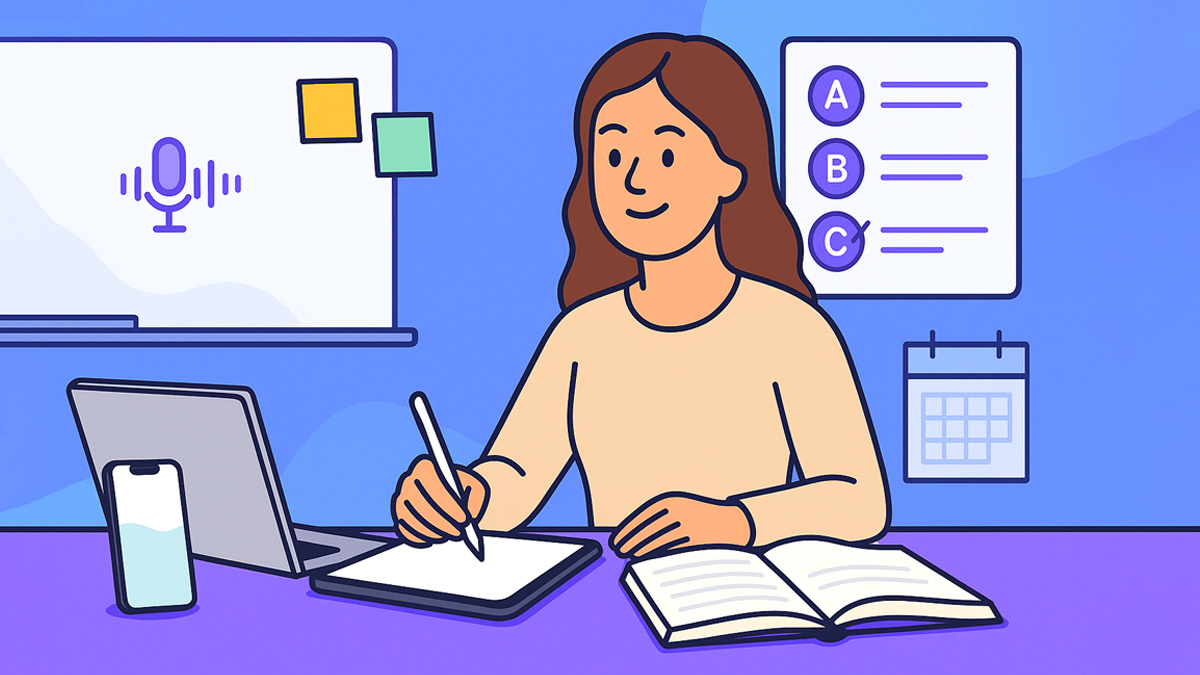AI note taking is revolutionizing how students learn and teachers teach. Using tools like ChatGPT, Clause or Gemini, you can now turn any lecture recording or transcript into quizzes, summaries, and study guides in minutes. Instead of just capturing notes, AI organizes lessons, extracts key points, and builds interactive quizzes that reinforce memory and understanding.
This guide explains how AI note-taking tools can help you convert lectures into personalized quizzes that make studying more active and effective. Whether you’re a student revising for exams or a teacher designing review materials, these methods save time and boost learning outcomes.
Why Turn Lectures Into Quizzes with AI?
AI-powered note takers go far beyond transcription—they actively transform how information is learned and retained. By converting lectures into quizzes, you can:
- Reinforce understanding by testing recall immediately after a class.
- Save hours creating practice questions or review materials.
- Identify gaps in comprehension through auto-generated question sets.
- Promote active learning as students engage with material rather than passively rereading notes.
Teachers gain automatic assessment tools, and students get instant feedback—all from a single lecture file.
How AI Note-Taking Tools Turn Lectures Into Quizzes
Modern AI note-taking systems like ChatGPT and Gemini analyze lecture transcripts, slides, or captions to extract key concepts and automatically generate question sets. Here’s how it works in practice:
- Transcribe your lecture or upload captions from YouTube, Zoom, or audio recordings.
- Summarize the transcript into key takeaways and learning objectives.
- Prompt the AI to create quizzes—multiple choice, short answer, or flashcards—from those summaries.
- Refine the output by adding context (e.g., “college biology,” “World War II lecture”) for accuracy and relevance.
AI tools also support exporting quizzes into apps like Anki or Quizlet, turning your lectures into complete study systems.
Best Practices for Using AI Note Taking
- Be clear and specific. Tell the AI exactly what you want—“Create 10 multiple-choice questions from this psychology lecture.”
- Include context. Mention course level or subject area to improve quiz quality.
- Use structure. Request bullet-point notes, question-answer format, or Bloom’s-level difficulty control.
- Review outputs. Edit, reorganize, or merge quiz results to ensure factual accuracy and clarity.
Following these principles ensures your AI-generated quizzes align with your learning goals and remain accurate across subjects.
Practical Examples of AI Note Taking in Education
- Lecture → Notes: “Summarize this 45-minute chemistry lecture into 12 concise bullet points.”
- Lecture → Quiz: “Generate a 10-question multiple-choice quiz with answers based on this economics lecture.”
- Lecture → Flashcards: “Turn this transcript into 20 flashcards using key concepts and definitions.”
- Lecture → Study Guide: “Create a one-page study guide with important dates, terms, and formulas from this history lesson.”
These examples show how AI converts passive listening into active, personalized learning. Try these techniques with your own lectures or explore curated AI quiz prompts for inspiration.
Final Thoughts
AI note taking turns every lecture into a study opportunity. By using tools like ChatGPT or Polar Notes AI, students can instantly turn lessons into quizzes, study guides, and flashcards, while teachers automate quiz generation and focus on teaching. Start with one class, refine your prompts, and you’ll quickly see how AI transforms your study routine into an interactive learning experience.
Explore more AI quiz prompts or try the free AI Study Guide Generator to turn your next lecture into a personalized review set.



